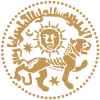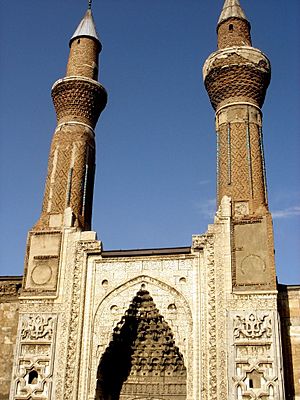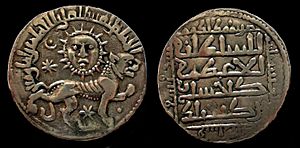Sultanate of Rum facts for kids
Quick facts for kids
Sultanate of Rûm
|
|||||||||||||||||||||
|---|---|---|---|---|---|---|---|---|---|---|---|---|---|---|---|---|---|---|---|---|---|
| 1077–1308 | |||||||||||||||||||||
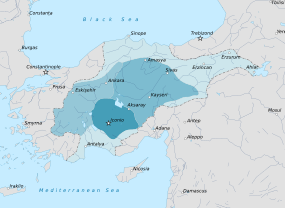
Expansion of the Sultanate c. 1100–1240
|
|||||||||||||||||||||
| Status | |||||||||||||||||||||
| Capital |
|
||||||||||||||||||||
| Common languages | Arabic (numismatics) Byzantine Greek (chancery, spoken) Old Anatolian Turkish (spoken) Persian (official, court, literature, spoken) |
||||||||||||||||||||
| Religion | Sunni Islam (official), Greek Orthodox (majority of population) | ||||||||||||||||||||
| Government | Hereditary monarchy Triarchy (1249–1254) Diarchy (1257–1262) |
||||||||||||||||||||
| Sultan | |||||||||||||||||||||
|
• 1077–1086
|
Suleiman ibn Qutalmish (first) | ||||||||||||||||||||
|
• 1303–1308
|
Mesud II (last) | ||||||||||||||||||||
| History | |||||||||||||||||||||
| 1071 | |||||||||||||||||||||
| 1077 | |||||||||||||||||||||
|
• Battle of Köse Dağ
|
1243 | ||||||||||||||||||||
|
• Karamanid conquest
|
1308 | ||||||||||||||||||||
|
|||||||||||||||||||||
| Today part of | Turkey | ||||||||||||||||||||
The Sultanate of Rûm was a powerful Muslim state in Anatolia (modern-day Turkey). It was founded by the Seljuk Turks after they won the Battle of Manzikert in 1071. This battle allowed them to take over lands from the Byzantine Empire. The name Rûm comes from the word for the Eastern Roman Empire and its people. This is why the Seljuks called their new state "Rûm."
The Sultanate of Rûm became separate from the larger Great Seljuk Empire in 1077. Its first capital was Nicaea, then it moved to Iconium. The Sultanate grew very strong in the late 1100s and early 1200s. It captured important ports on the Mediterranean and Black Sea coasts. This helped them control trade routes across Anatolia. They even traded a lot with the city of Genoa. Their wealth allowed them to take over other smaller Turkish states in Anatolia.
However, the Sultanate faced many challenges, including the Crusades. In 1243, the Mongols defeated them at the Battle of Köse Dağ. After this, the Seljuks became a vassal (a state controlled by another) of the Mongol Empire. Their power slowly faded away. The last Seljuk sultan was killed in 1308. When the Sultanate ended, many small Turkish states, called beyliks, appeared. One of these was the Ottoman dynasty, which eventually grew to become the mighty Ottoman Empire.
Contents
History of the Sultanate
How the Sultanate Started
Turkish groups began moving into Anatolia from the 1030s, looking for new lands. After the Battle of Manzikert in 1071, a Seljuk commander named Suleiman ibn Qutulmish gained control of western Anatolia. Between 1075 and 1081, he took over Byzantine cities like Nicaea (now İznik) and Nicomedia (now İzmit).
Around 1077, Suleiman created his own state. At first, it was a vassal of the Byzantine Empire, but it soon became independent. Suleiman's son, Kilij Arslan I, was imprisoned for a while. But when the Great Seljuk sultan died in 1092, Kilij Arslan was freed. He then took control of his father's lands.
The Crusades and Growth
Kilij Arslan I fought against the First Crusade in 1096. He won against the People's Crusade, but was defeated by the main Crusader army. He moved his capital to Konya in central Anatolia. In 1101, he defeated three more Crusader groups. He died in 1107 while fighting in the east.
Later, Mesud I, Kilij Arslan's son, took control of Konya in 1116. By the time Mesud died in 1156, the Sultanate controlled most of central Anatolia. His son, Kilij Arslan II, was the first Seljuk ruler to officially use the title of sultan. He defeated a Byzantine army at the Battle of Myriokephalon in 1176. Even though the Third Crusade briefly took Konya in 1190, the Sultanate quickly recovered.
Under Kaykhusraw I and his successors, Kaykaus I and Kayqubad I, the Seljuk Sultanate reached its peak. Kaykhusraw captured the port of Attalia on the Mediterranean coast in 1207. His son Kaykaus took Sinop and made the Empire of Trebizond a vassal state in 1214. Kayqubad continued to expand the lands along the Mediterranean coast from 1221 to 1225. He also sent an army across the Black Sea to Crimea.
The Mongol Invasion and Decline
Kaykhusraw II became sultan in 1237. In 1239, he faced a big uprising led by a preacher named Baba Ishak. This revolt weakened the Sultanate's army. Then, a much bigger threat appeared: the Mongol Empire. Mongol forces captured Erzurum in 1242. In 1243, the Mongols, led by Baiju, crushed the Seljuk army at the Battle of Köse Dağ. The Seljuk Turks were forced to become vassals of the Mongols.
After the battle, Kaykhusraw II fled and died in 1246. His death led to a period where his three sons shared power. The Seljuk lands were divided among them. By 1256, all of Anatolia was officially under Mongol control. The Seljuk sultans became puppet rulers, with real power held by the Mongols or powerful regents.
The End of the Sultanate
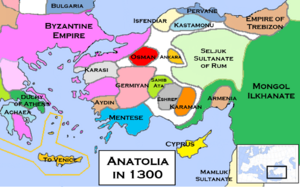
The Seljuk state began to break into many small emirates, called beyliks. These beyliks became more independent from both Mongol and Seljuk control. In 1277, the Mamluk Sultan Baibars attacked Anatolia and defeated the Mongols. However, he had to return to Egypt, and the Mongols regained control.
By the end of his rule, Sultan Kaykhusraw III only directly controlled the lands around Konya. Other beyliks still recognized the sultan's authority in name. When Kaykhusraw III was killed in 1284, the Seljuk dynasty faced more internal problems. In 1303, Mesud II became sultan in Kayseri. He was murdered in 1308, and his son died soon after. A distant relative briefly ruled Konya, but the Karamanids conquered his lands in 1328. This marked the official end of the Sultanate of Rûm.
Culture and Society
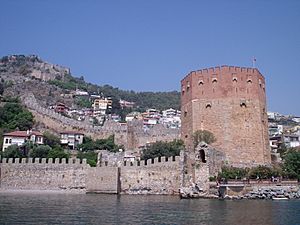
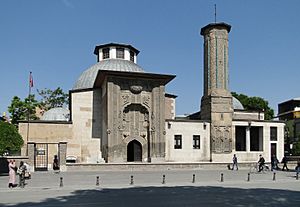
The Seljuk sultans of Rûm followed the Persian-Islamic culture. They even gave their sons Persian names like Kay-Khusraw and Kay-Qubadh. They supported Persian art, architecture, and literature. Many officials and religious leaders in their state were Persian. In the 1200s, most Muslim people in major Anatolian cities spoke Persian. Anatolia became like a "second Iran" in terms of culture.
Even though the Seljuks were of Turkic origin, they used Persian for government work. Their history books were also written in Persian, not Turkish. Sultan Kilij Arslan II even spoke Persian as a child. A famous Persian writer, Rumi, got his name from the state. He was known as "Rumi" because he lived in Rûm.
The Seljuks built many impressive buildings. These included caravanserais (roadside inns for travelers and traders), madrasas (schools), and mosques. They used stone in their buildings, inspired by Iranian Seljuk and local Byzantine designs. This made Anatolian architecture very unique and beautiful.
One of the largest caravanserai is the Sultan Han, built in 1229. It is located between Konya and Aksaray. Another famous one is the Hekimhan caravanserai. It has inscriptions in Arabic, Armenian, and Syriac. This is because it was built by Sultan Kayqubad I's doctor, who was thought to be a Christian who converted to Islam.
The Seljuk sultans also had special guards called ghulams. These were young enslaved men from non-Muslim groups, often Greeks from former Byzantine lands. This practice might have influenced the later devşirme system in the Ottoman Empire.
Seljuk Sultans of Rûm
The names of the sultans can be spelled differently. This depends on whether the source uses the original Persian spelling or the modern Turkish spelling. Some sultans also used two names. For example, Sultan Kayqubad I built palaces named Kubadabad and Keykubadiye. But he named his mosque in Konya the Alâeddin Mosque and the city he captured, Alanya, as "Alaiye".
| Sultan | Reign | Notes |
|---|---|---|
| 1. Qutalmish | 1060–1064 | Fought for the throne of the larger Seljuk Empire. |
| 2. Suleiman ibn Qutulmish | 1075–1077 de facto rules Turkmen around İznik and İzmit; 1077–1086 recognised Sultan of Rûm by Malik-Shah I of the Great Seljuks |
Founder of the Anatolian Seljuk Sultanate. Capital was İznik. |
| 3. Kilij Arslan I | 1092–1107 | First sultan to rule from Konya. |
| 4. Malik Shah | 1107–1116 | |
| 5. Masud I | 1116–1156 | |
| 6. 'Izz al-Din Kilij Arslan II | 1156–1192 | |
| 7. Giyath al-Din Kaykhusraw I | 1192–1196 | First time as ruler. |
| 8. Rukn al-Din Suleiman II | 1196–1204 | |
| 9. Kilij Arslan III | 1204–1205 | |
| (7.) Giyath al-Din Kaykhusraw I | 1205–1211 | Second time as ruler. |
| 10. 'Izz al-Din Kayka'us I | 1211–1220 | |
| 11. 'Ala al-Din Kayqubad I | 1220–1237 | |
| 12. Giyath al-Din Kaykhusraw II | 1237–1246 | After his death, the Sultanate was split until 1260. |
| 13. 'Izz al-Din Kayka'us II | 1246–1262 | |
| 14. Rukn al-Din Kilij Arslan IV | 1249–1266 | |
| 15. 'Ala al-Din Kayqubad II | 1249–1254 | |
| 16. Giyath al-Din Kaykhusraw III | 1266–1284 | |
| 17. Giyath al-Din Masud II | 1282–1296 | First time as ruler. |
| 18. 'Ala al-Din Kayqubad III | 1298–1302 | |
| (17.) Giyath al-Din Masud II | 1303–1308 | Second time as ruler. |
See also
 In Spanish: Sultanato de Rum para niños
In Spanish: Sultanato de Rum para niños
- Timeline of the Seljuk Sultanate of Rûm
- Babai Revolt
- Byzantine–Seljuk Wars
- List of battles involving the Seljuk Empire
- Rûm Province, Ottoman Empire
Sources
82



